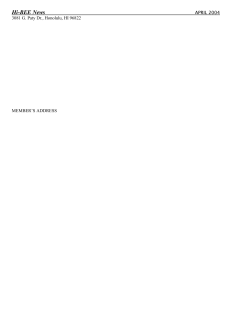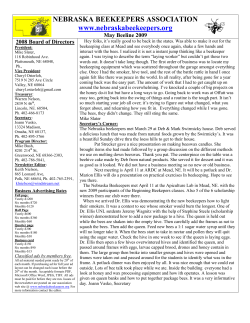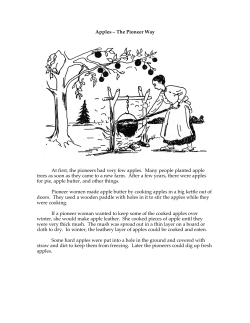
Hard Honey Cider
Hard Honey Cider What is hard cider? Hard cider refers to the fermented beverage made from the juice of apples. Unfermented or sweet cider is fresh pressed apple juice. For most Americans, the word cider conjures up images of freshly pressed apple juice. However, in all other parts of the world, the word cider refers to the fermented, alcoholic beverage made from pressed juice. Hard cider can range from sweet to dry depending on the type of apples and yeast used and the length of fermentation. It can be pasteurized and filtered to produce a draft hard cider, or left unfiltered as in farmhouse hard cider. Hard cider, the American term for the alcoholic beverage, is a light-tasting, slightly sweet drink with approximately the same alcohol content as beer. Hard cider is typically made from a blend of juices from bittersweet and culinary apples. Where did hard cider originate? Hard cider is believed to have developed from wine making technology in the Basque country of northern Spain. Celts then spread cider-making technology throughout the northern coast of Europe as they traveled from Spain to England and Ireland. Cider is produced in four main styles: still cider is uncarbonated, sparkling cider is lightly carbonated, New England hard cider may be still or sparkling, but contains elevated levels of alcohol (over 8 percent) and specialty hard cider is made with added sugar, honey, molasses, or fruit. National Honey Board The European hard cider industry flourished until the industrial revolution when thousands left their farms for cities and beer became the beverage of choice. However, interest in hard cider continued among the American colonists who • (800) 553-7162 • brought apples and cidermaking technology to the New World. During the colonial period, hard cider was the beverage of choice. It was cheaper than beer and could easily be made at every farmhouse. It wasn’t until the 1900’s that hard cider decreased in popularity. Prohibition and the mass production of beer during the American industrial revolution led to its downfall. Today, however hard cider is making a strong comeback and there is increasing awareness and appreciation of this traditional beverage. The United Kingdom leads the world in hard cider production and consumption, but the United States is catching up. There are approximately 60 cider manufacturers in the UK and approximately 30 in the U.S. Of the 30 in the U.S., about two-thirds produce draft hard ciders and the remaining third produces farmhouse hard ciders. www.honey.com • Page 1 of 8 Hard cider produced in England is generally more tannic and ale-like due to their use of ale yeast and bittersweet apples. The cider made in the U.S. is generally sweeter and more champagne-like. There are four basic types of apples: sweet apples include Baldwin, Cortland, Delicious and Rome Beauty; acidic apples are Northern Spy, Winesap, Greening and Pippin; aromatic apples include Macintosh and Russet and astringent apples are basically wild apples and crabapples. Honey’s advantages in hard cider Honey imparts a sweet, smooth, mellow taste and pleasant floral scent to hard cider. It also increases the alcohol content of the cider by increasing the specific amount of sugars available for fermentation. NOTE: Honey adds 35 gravity points per pound of honey per gallon of cider. Making hard honey cider Honey naturally raises the specific gravity of pressed apple juice and imparts a smooth honey taste to hard cider. The specific gravity of fresh pressed apple juice is approximately 0.050. At this level, fermentation of the sugars present produces a hard cider with an alcohol content of 6 percent. However, contamination by yeast and bacteria is still possible. Therefore, many manufacturers raise the specific gravity of their product to create a hard cider with a higher alcohol content and longer shelflife. National Honey Board Cider making begins with apple selection. Most ciders are a blend of juices from several apple varieties. A typical blend of apples would include approximately 50 percent sweet apples, 35 percent acidic apples and 5 percent astringent apples. As a rule of thumb it takes 100 pounds of apples to make 8 gallons of juice. Milling and Pressing The cider brewer must decide whether to buy fresh pressed apple juice or press it themselves. When buying pressed juice, the cider manufacturer has no control over the types of apples used and whether preservatives have been added. Milling and pressing can be expensive and laborious, but brewers • (800) 553-7162 • have more control over the cider processed. Honey Cider Facts • Milder honeys should be added to cider because darker honeys will overpower the apple taste. • A honey-flavored cider with a majority of the fermentable material coming from apples is a honeyflavored specialty cider. • If the majority of fermentable material comes from honey then it is an appleflavored mead. Once the apples have been selected, they are milled or ground to produce apple pulp, called pomace. The pomace is then pressed to obtain apple juice. Some brewers treat the juice, called must, with sulfites to reduce bacteria and wild yeasts. Some prefer to skip this step and allow wild yeasts present in the juice to begin ferment. If fermentation with wild yeast is not preferred, one to two Campden (potassium metabisulphite) tablets per gallon will kill all unwanted organisms. After adding sulfite, the juice should be aerated for 24 hours before adding yeast to prevent its destruction. www.honey.com • Page 2 of 8 Once the juice has been pressed, the specific gravity, pH and tannin level must be checked with a hydrometer and enough honey should be added to reach a specific gravity of approximately 1.060. However, the amount of honey added depends on the preferred alcohol content of the finished cider. The more honey added, the higher the alcohol content will be. The pH of the pressed juice should be in the range of 3.9 to 4.0. To lower the pH add malic acid (the principle acid in cider) and to raise the pH add precipitated chalk. The correct level of acid is essential because it balances the alcohol in the cider and helps protect it from contamination. Tannin is found in crabapples and is what gives them their astringent taste. In cider it provides long-term structure and a pleasant dry taste. The tannin level of the juice will need to be adjusted if the juice was pressed from sweet apples such as Red Delicious. One teaspoon of tannin powder for every five gallons of pressed juice is needed when sweet apples are used. However, if the correct blend of sweet, aromatic, acidic and National Honey Board astringent apples are used, acid and tannin will not need to be adjusted. Fermentation After honey has been added and any adjustments have been made, the juice is ready for fermentation. Cider undergoes two different kinds of fermentation. The first is carried out by yeast which have either been added or are naturally present. This fermentation converts sugars to ethanol and alcohol. The second fermentation involves the conversion of malic acid to lactic acid and carbon dioxide by lactic acid bacteria. The temperatures necessary for primary and secondary fermentation are often different. Temperatures for primary fermentation depend on the type of yeast used, while secondary fermentation should occur at temperatures below 55° F (13° C). Many types of yeasts can be used to ferment cider. Yeasts that add little character and flavor and do not mask the delicate apple taste are typically preferred. Champagne yeasts which are capable of converting more of the natural fruit sugars to alcohol and which do not impart flavor are often used by cider manufacturers. • (800) 553-7162 • Fermentation action usually stops within two to three months when acid and alcohol levels build up in the juice. After Honey Hints To produce a more alcoholic and dry honey cider, the honey added should be allowed to ferment to completion. However, the final product will only have a slight honey flavor. To produce a sweeter, less alcoholic and more honey flavored cider, fermentation should be shortened to prevent the entire consumption of honey by the yeast. fermentation subsides, the cider is left for the yeast to settle and is either coldfiltered, centrifuged or simply siphoned to another bottle to separate the dormant yeast from the juice. Cider can be stored in any type of bottle that can be sealed with a cap or a cork. Capped bottles may be used to store still (uncarbonated) cider or cider that has been primed to become sparkling cider (carbonated). Corked bottles are only used with still cider because the pressure that builds inside a sparkling cider would pop the cork. The cider should be stored for at least six months in a dark place to age. The www.honey.com • Page 3 of 8 cider should be stored at 65 to 72° F (18 to 24° C) to let the flavors mellow and the edges soften. However, the length of aging depends on the style of cider being made. Light, sparkling ciders require less time, while stronger ciders may take anywhere from three months to a year to fully mature. Where to find more information The Art of Cidermaking, by Paul Correnty provides step by step instruction on the production of cider. The honey cider recipes on the following pages have been taken from Correnty’s book with permission. If you have access to the Internet, two interesting Web sites are: The Real Cider and Perry page (http://web.bham.ac.uk/Grafto nG/cider/homepage.htm), and The Brewery page (http://www.brewery.org/brew ery/cm3/recs/11_toc.html). Also, a quick search on the Internet can provide you with a wealth of information. National Honey Board • (800) 553-7162 • To create a sparkling cider, a small amount of sugar must be added to the cider before it is capped and stored. This process is called priming. To prime five gallons of cider boil half cup of cane or corn sugar together with a pint of water for five minutes. Let cool before mixing with your cider. Then pour into a large container before racking the cider. The sugar syrup will activate the dormant yeast still alive in the unfiltered and unsufited cider. With no escape from the capped bottles, the carbon dioxide from the yeast will be absorbed by the cider to create sparkling bubbles. www.honey.com • Page 4 of 8 Honey Cider Formulas Gorman’s Robust Cyser Bit O’ Honey Cyser Ingredients for five gallons • 5 gallons fresh pressed sweet cider, tested and adjusted for acid. • 2 pounds clover honey (or enough to bring the specific gravity up to approximately 1.065). • ale or mead (honey wine) yeast starter. Procedure: Simmer the honey with a bit of cider over a low flame until the honey warms and thins. Pour a gallon of sweet cider into a sanitized glass carboy to its shoulders with sweet cider. Pitch (add) the yeast, top off with the remaining sweet cider, and cover the top of the carboy with plastic wrap. Since ale or mead yeast is being used keep the cider between 65 and 75° F (18 and 24° C). Ingredients for five gallons • 5 gallons fresh pressed sweet cider, tested and adjusted for acid. • 7 pounds mild honey (or enough to bring the specific gravity up to approximately 1.150). • 1 tablespoon ground cinnamon. • 1 pack dried Epernay wine yeast or yeast culture. Procedure: Warm the honey with a gallon of cider over low flame to thin it before adding it and the cinnamon to the carboy full of sweet cider. Pitch the yeast or yeast culture and ferment as for the Bit O’ Cyser recipe. Two things to note: 1. Epernay wine yeast is used because it has a high tolerance for alcohol. It will ferment more of the honey before settling out than will a low-tolerance beer yeast. 2. With such a large amount of honey, fermenting this cider and achieving the proper balance of tastes may take considerable time, maybe up to a year, so be patient. Fermentation begins very slowly as the heavier honey settles, then works very rapidly as the yeast feast on the large amounts of sugar in the blend. Wipe up and sanitize the overflow and top off and add a fermentation lock when the cider settles. The procedures for cyser are identical to cider with a notable exception: honey takes a longer time to clear and even longer time to ferment out and taste acceptable (at least 6 months). This cider will keep in a bottle for up to four years. The honey cyser will finish dry and have a lingering honey sweetness. Cyser may be bottled still and capped or corked, or may be made sparkling with the addition of a simple syrup of one-half cup sugar and two cups water and boiled for five minutes and cooled to five gallons of cyser. Let the bottled cyser age in a cool place for at least four months before drinking. National Honey Board • (800) 553-7162 • www.honey.com • Page 5 of 8 Ginger Honey Cider Ingredients for five gallons • 5 gallons fresh pressed sweet cider • 3 cups cane or corn sugar • 2 cups clover or other mild honey • 1 to 4 ounces freshly grated ginger • lager or ale beer yeast culture Procedure: Dissolve the sugars and honey in one gallon of warmed cider and add to the other four gallons already in the sanitized carboy. Pitch the active yeast culture, fill the carboy to within two inches of the top and cover the opening with plastic wrap. Keep the carboy at room temperature until fermentation starts. Then carefully move the carboy to a cool place, below 55° F (13° C). Primary fermentation at these temperatures will last at least one month, so remember to wipe down the carboy daily with sanitizing solution. At the end of primary fermentation, add the freshly grated ginger, top off the carboy with fresh cider, and attach a fermentation lock. At this point, the cider may be left to ferment at cool temperatures. Secondary fermentation is characterized by a steady stream of rising bubbles that slowly subsides then cease when all the sugars have been converted. It will be clear and ready to bottle within two to three months. It may take a few months for the flavors of Gingered Honey Cider to mellow after fermentation is completed. At bottling the ginger will still be sharp and not yet blended into the apple and honey base. This cider may be bottled still or made sparkling. Rack the cider into a sanitized five-gallon container and add a boiled and cooled solution of one-half cup sugar and one cup water before bottling and capping. National Honey Board • (800) 553-7162 • www.honey.com • Page 6 of 8 Stokes Sensational Elderberry Cider This is about as rich a cyser as one gets. The color is deep burgundy, the aroma is a wild mixture of crushed berries and fragrant honey with apple peeking through. And the taste…big, big, BIG! Berries and honey cascade down balanced by apple acidity and the tannin of the elderberries. The finish is rich and riotous and very long, in the end the elderberries give way to the kiss of honey. This is the first cyser made by Martin Stokes, an accomplished brewer and cidermaker who won it all in 1994 as the AHA Cidermaker of the Year. Ingredients for five gallons • 4.5 gallons fresh pressed apple juice at 65° F • 4 12-ounce cans Seneca Granny Smith apple juice concentrate. • 5 pounds clover honey. • 16 pounds elderberry (these may be picked fresh and frozen until needed). • 1 tsp. yeast nutrient. • ½ tsp. yeast hulls. • ½ tsp. liquid pectin enzyme. • 1 package dried champagne yeast, rehydrated following package instructions. Procedure: Roughly crush the berries and mix them together with 3 gallons of the cider (put the rest back in the fridge) and the other ingredients except the yeast in a wide food grade plastic fermenting bucket or stainless steel fermenter. Pitch the yeast and cover with cheesecloth to keep our critters. Ferment the berries until the specific gravity drops by half. Using a large mesh strainer, strain the floating berries out then rinse them with the remaining 1 ½ gallons of sweet cider over the bucket to catch all the juice. Siphon the cyser out of the bucket into a clean 5 gallon carboy and attach a water lock. Place in a dark and quiet part of the cellar and let the cyser finish fermenting until it drops clear, another 3 or 4 months. Herb’s Happy Honey Cider This cyser is pale yellow and very clean with sweet apple and honey aromas. It is medium weight and delicate in taste with a refreshing honeyed finish. This is a favorite libation of Herbert Peach, blue ribbon winner in the Cider category at the 1997 Boston Homebrew Competition. Ingredients for five gallons • 5 gallons fresh pressed sweet cider at 75° F. • 4 cups granulated sugar. • 2 pounds clover honey. • M&F dried ale yeast. Procedure: In a clean carboy mix together 1 gallon of the cider, the sugar, and the liquefied honey then swirl gently until dissolved. Pour in the remaining cider. Rehydrate the dried yeast according to the package instructions and pitch. Attach water lock or blowoff tube and when yeast starts to work, bring the carboy down to cellar so that it may ferment at a temperature between 55° F and 60° F to maintain its fruity aroma. Let the cyser ferment in a primary until only a few bubbles rise to the surface and the cyser starts to clear (3 or 4 months), then rack into a clean carboy. The fermentation will slowly continue for another month until all activity stops and the cyser is very clear. Bottle and enjoy now or bottle and age for further maturity. At this time the cyser may be primed and bottled, or left to mature in bulk. Be aware that there is much that went into this cyser and it will take at least 8 or 9 months for the tannins in the elderberries to mellow and the complex honey taste to develop. It is a good idea to make other, quicker maturing cysers for early drinking so that this one may be allowed to age gracefully…you will be glad you did! National Honey Board • (800) 553-7162 • www.honey.com • Page 7 of 8 SELECTED HONEY FLORAL SOURCES It All Depends Where the Bees Buzzed! Type of Honey Acacia Honey Pale yellow color. Delicate flavor. Light amber color. Mild flavor and aroma. Water-white color. Strong “biting” flavor. Dark amber color. Strong, slightly malty flavor. Alfalfa Honey Basswood Honey Buckwheat Honey Blueberry Honey Clover Honey Eucalyptus Honey Heather Honey Orange Blossom Honey Sage Honey Safflower Honey Sourwood Honey Tupelo Honey Mixed Wildflower Honey Distinguishing Characteristics Production Produced in California. Light amber color. Distinct fruity flavor. Color varies from water white to amber. Mild, “classic honey” flavor. Varies greatly in color. Generally strong flavor with very slight menthol notes. Reddish brown to deep amber color. Heavybodied. Bittersweet, aromatic flavor. Light amber color. Mild, flavor reminiscent of the scent of citrus blossoms. Water-white color. Mild flavor. Color varies from amber to dark amber with slight greenish cast. Mild flavor. Light amber color. Mild flavor. Light amber color with slight greenish cast. Mild, distinctive flavor. Very slow to crystallize. Varied greatly in color and flavor. Typically strong flavor. Produced extensively throughout Canada and U.S. Produced from southern Canada to Alabama and Texas. Produced in Minnesota, New York, Ohio, Pennsylvania and Wisconsin as well as in eastern Canada. Produced in eastern and southeastern states and Canada. Produced throughout the U.S. Produced in California and Australia. Produced in Michigan, New Jersey and West Virginia. Produced in Florida, southern California and southern Texas. Produced in California and southwest U.S. Produced throughout the western U.S. Produced in the eastern areas of the U.S. Produced in northeastern Florida. Produced throughout the U.S. DID YOU KNOW? The average worker bee makes 1/12 of a teaspoon of honey in her lifetime. National Honey Board • (800) 553-7162 • www.honey.com • Page 8 of 8
© Copyright 2025












